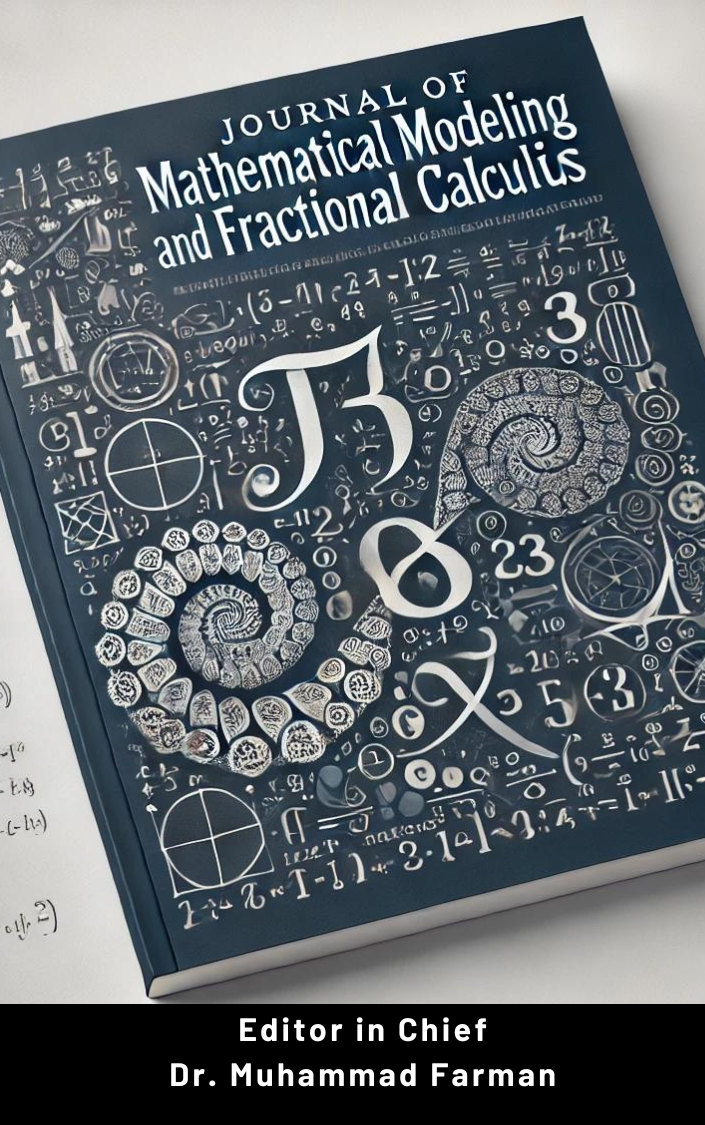Investigation of COVID-19 outbreak as a case study in Italy using different fractional operators
DOI:
https://doi.org/10.48165/jmmfc.2024.1103Keywords:
Mathematical modeling, Boundedness, Existence, Stability analysisAbstract
This work analyzes the COVID-19 fractional order SEIQRD compartmental model using the six primary categories of the Caputo approach. Numerous conclusions have been drawn on the the solution’s boundedness and non-negativity, as well as the existence and uniqueness of the new mod el. Our findings reveal that the When R0 < 1, the system is locally asymptotically stable at infection-free equilibrium. We also observed that In the absence of illness, the system is globally asymptotically stable (R of Covid 19 <1). This study’s primary goal is to look into the dynamics of COVID-19 transmission in Italy, the nation where the virus was initially discovered in January 2020. To account for the uncertainty arising from the limited knowledge about the Corona virus (COVID-19), The order of fractions A fractional order was used to apply the SEIQRD compartmental model framework. The dynamics of the equilibrium are examined using the La Salle invariant principle and the Routh-Hurwitz consistency criterion. Additionally, the suggested model’s approximate solution is calculated using the fractional-order Taylor’s method. Through the comparison of simulation results with empirical data, the model’s validity is shown. The study’s findings regarding the impacts of using face masks showed that wearing face masks frequently can prevent the COVID-19 virus from spreading.
References
[1] Chan, Jasper Fuk-Woo, et al. ”Genomic characterization of the 2019 novel human-pathogenic coro navirus isolated from a patient with atypical pneumonia after visiting Wuhan.” Emerging microbes and infections 9.1 (2020): 221-236.
[2] World Health Organization. Laboratory testing for coronavirus disease 2019 (COVID-19) in sus pected human cases: interim guidance, 2 March 2020. No. WHO/COVID-19/laboratory/2020.4. World Health Organization, 2020.
[3] Lu, Hongzhou, Charles W. Stratton, and Yi-Wei Tang. ”Outbreak of pneumonia of unknown eti ology in Wuhan, China: The mystery and the miracle.” Journal of medical virology 92.4 (2020): 401.
[4] D’Arienzo, Marco, and Angela Coniglio. ”Assessment of the SARS-CoV-2 basic reproduction num ber, R0, based on the early phase of COVID-19 outbreak in Italy.” Biosafety and health 2.2 (2020): 57-59.
[5] Aldila, Dipo, et al. ”A mathematical study on the spread of COVID-19 considering social distancing and rapid assessment: The case of Jakarta, Indonesia.” Chaos, Solitons and Fractals 139 (2020): 110042.
[6] Global, T., and O. Alert. ”Coronavirus disease 2019 (COVID19).” Geneva: world health organiza tion (2020).
[7] Alnaser, Waheeb E., Mahmood Abdel-Aty, and Omar Al-Ubaydli. ”Mathematical prospective of coronavirus infections in Bahrain, Saudi Arabia and Egypt.” Inf Sci Lett 9.1 (2020): 51-64.
[8] Ming, Wai-Kit, Jian Huang, and Casper JP Zhang. ”Breaking down of healthcare system: Mathe matical modelling for controlling the novel coronavirus (2019-nCoV) outbreak in Wuhan, China.” BioRxiv (2020).
[9] Nesteruk, Igor. ”Statistics-based predictions of coronavirus epidemic spreading in mainland China.” (2020).
[10] Batista, Milan. ”Estimation of the final size of the coronavirus epidemic by the logistic model.” medrxiv (2020): 2020-02.
[11] Okhuese, Victor Alexander. ”Mathematical predictions for COVID-19 as a global pandemic.” medrxiv (2020): 2020-03.
[12] Ivanov, Dmitry. ”Predicting the impacts of epidemic outbreaks on global supply chains: A simulation-based analysis on the coronavirus outbreak (COVID-19/SARS-CoV-2) case.” Trans portation Research Part E: Logistics and Transportation Review 136 (2020): 101922.
[13] Li, Lixiang, et al. ”Propagation analysis and prediction of the COVID-19.” Infectious Disease Mod elling 5 (2020): 282-292.
[14] Cooper, Ian, Argha Mondal, and Chris G. Antonopoulos. ”A SIR model assumption for the spread of COVID-19 in different communities.” Chaos, Solitons and Fractals 139 (2020): 110057.
[15] Fanelli, Duccio, and Francesco Piazza. ”Analysis and forecast of COVID-19 spreading in China, Italy and France.” Chaos, Solitons and Fractals 134 (2020): 109761.
[16] Petropoulos, Fotios, and Spyros Makridakis. ”Forecasting the novel coronavirus COVID-19.” PloS one 15.3 (2020): e0231236.
[17] Chintalapudi, Nalini, Gopi Battineni, and Francesco Amenta. ”COVID-19 virus outbreak forecast ing of registered and recovered cases after sixty day lockdown in Italy: A data driven model ap proach.” Journal of Microbiology, Immunology and Infection 53.3 (2020): 396-403.
[18] Nafea, Marwan, et al. ”Hybrid PSO-Tuned PID and hysteresis-observer based control for piezo electric micropositioning stages.” 2019 IEEE International Conference on Smart Instrumentation, Measurement and Application (ICSIMA). IEEE, 2019.
[19] Smethurst, Dominic P., and Hywel C. Williams. ”Are hospital waiting lists self-regulating?.” Nature 410.6829 (2001): 652-653.
[20] Meerschaert, Mark M., and Alla Sikorskii. Stochastic models for fractional calculus. Vol. 43. Walter de Gruyter GmbH and Co KG, 2019.
[21] Gomez-Aguilar, J. F., et al. ”Analysis of fractalfractional malaria transmission model.” Fractals 28.08 (2020): 2040041.
[22] Atangana, Abdon. ”Modelling the spread of COVID-19 with new fractal-fractional operators: can the lockdown save mankind before vaccination?.” Chaos, Solitons and Fractals 136 (2020): 109860.
[23] Khan, Hasib, et al. ”A fractional order HIV-TB coinfection model with nonsingular Mittag-Leffler Law.” Mathematical Methods in the Applied Sciences 43.6 (2020): 3786-3806.
[24] Shah, Kamal, et al. ”Semi-analytical study of Pine Wilt Disease model with convex rate under CaputoFebrizio fractional order derivative.” Chaos, Solitons and Fractals 135 (2020): 109754.
[25] Yousaf,M.,Zahir,S.,Riaz,M.,Hussain,S.M.,Shah,K.:Statistical analysis of forecasting COVID-19 for upcoming month in Pakistan.Chaos Solitons Fractals 138,109926(2020)
[26] Ud Din, Rahim, et al. ”Study of transmission dynamics of novel COVID-19 by using mathematical model.” Advances in Difference Equations 2020 (2020): 1-13.
[27] Shah, Kamal, Fahd Jarad, and Thabet Abdeljawad. ”On a nonlinear fractional order model of dengue fever disease under Caputo-Fabrizio derivative.” Alexandria Engineering Journal 59.4 (2020): 2305- 2313.

